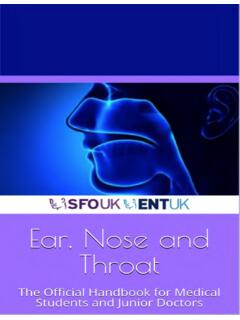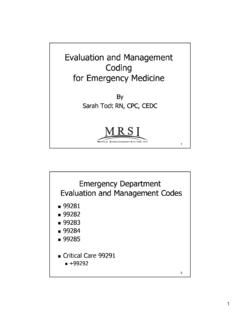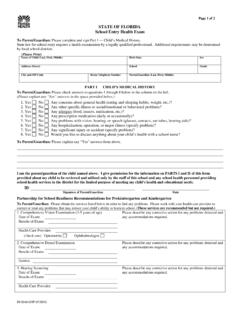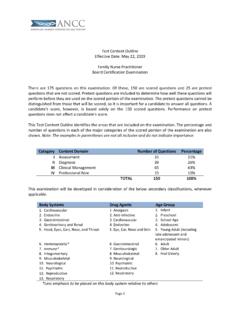Transcription of CDC/NHSN Surveillance Definitions for Specific Types of ...
1 January 2018 17- 1 Surveillance Definitions CDC/NHSN Surveillance Definitions for Specific Types of Infections INTRODUCTION This chapter contains the CDC/NHSN Surveillance Definitions and criteria for all Specific Types of infections. This chapter also provides additional required criteria for the Specific infection Types that constitute organ space surgical site infections (SSI) ( for example, mediastinitis [MED] that may follow a coronary artery bypass graft, intra-abdominal abscess [IAB] after colon surgery, etc.). Comments and reporting instructions that follow the site- Specific criteria provide further explanation and are integral to the correct application of the criteria.
2 Refer to Chapter 2 (Identifying HAIs in NHSN) for Specific guidance for making HAI determinations. Infection criteria contained in this chapter may be necessary for determining whether a positive blood specimen represents a primary bloodstream infection (BSI) or is secondary to a different type of infection (see Appendix B Secondary Bloodstream Infection (BSI) Guide). A BSI that is identified as secondary to another site of infection must meet one of the infection criteria detailed in this chapter and meet other requirements. Secondary BSIs are not reported as Laboratory Confirmed Bloodstream Infections in NHSN, nor can they be associated with the use of a central line.
3 NOTES: See individual protocol chapters for infection criteria for urinary tract infections (UTI), bloodstream infections (BSI), pneumonia (PNEU), ventilator-associated infections (VAE), and surgical site infections (SSI). Organisms belonging to the following genera cannot be used to meet any NHSN definition: Blastomyces, Histoplasma, Coccidioides, Paracoccidioides, Cryptococcus and Pneumocystis. These organisms are typically causes of community-associated infections and are rarely known to cause healthcare-associated infections, and therefore are excluded. Antibiograms of the blood and isolates from potential primary sites of infection do not have to match for purposes of determining the source of BSIs (see matching organisms below).
4 A matching organism is defined as one of the following: 1. If genus and species are identified in both specimens, they must be the same. a. Example: An intraabdominal specimen is used as an element to meet IAB definition and is growing Enterobacter cloacae. A blood specimen with a collection date in the IAB secondary BSI attribution period is reported to be growing Enterobacter cloacae. These are considered matching organisms. b. Example: An intraabdominal specimen is used as an element to meet IAB definition and is growing Enterobacter aerogenes. A blood specimen with a collection date in the IAB secondary BSI attribution period is reported to be growing Enterobacter cloacae.
5 These are NOT considered matching organisms as the species are different. January 2018 17- 2 Surveillance Definitions 2. If the organism is less definitively identified in one specimen than the other, the lesser identified organism must be identified to at least the genus level and at that level the organisms must be the same. a. Example: A surgical wound growing Pseudomonas species is used to meet deep incisional SSI criteria and a blood specimen growing Pseudomonas aeruginosa is collected in the SSI secondary BSI attribution period. The organisms are considered matching at the genus level and therefore the BSI is secondary to the SSI.
6 B. Example: PCR identifying Enterococcus faecalis in CSF meets the MEN definition. A subsequent blood culture collected in the MEN secondary BSI attribution period is identified as Enterococcus species. The organisms are considered to be matching and therefore the BSI is secondary to MEN 3. There are two exceptions to the definition: a. Infections meeting LCBI 2 criteria with staphylococcus or streptococcus Example-(staphylococcus): A patient has a fever and a previous chest tube site is reddened, swollen and a culture is collected from the soft tissue. The chest tube site culture is reported positive for Staphylococcus species.
7 SST/ST definition is met. The next day 2 blood culture sets are collected. The blood cultures are both positive for coagulase negative Staphylococcus. The organisms are NOT considered matching, because Staphylococcus species could represent a coagulase negative or a coagulase positive Staphylococcus. Therefore the BSI would not be considered secondary to SST/ST. Example-(streptococcus): A patient has a fever and a previous chest tube is reddened swollen and a culture is collected from the soft tissue. The chest tube site culture is reported positive for Streptococcus species. SST/ST definition is met.
8 The next day 2 blood culture sets are collected. The blood cultures are both positive for Streptococcus, viridans group. The organisms are NOT considered matching, because Streptococcus species could represent a Streptococcus, viridans group or non- Streptococcus, viridans group. Therefore the BSI would not be considered secondary to SST/ST. b. In cases where an organism is identified only as yeast or yeast not otherwise specified , the organism can be considered a match to other yeasts, when collected during the required timeframe, whether more fully identified or not. Example: A culture of tissue from ulcer margin of a decubiti reported positive for yeast is used as an element to meet DECU definition.
9 A blood specimen collected in the secondary BSI attribution period of the DECU is reported as Candida albicans. In this example the two organisms are considered matching organisms as the organisms are complementary (specifically, Candida is a type of yeast) and because yeasts isolated from non-sterile sites are commonly not identified to the genus or genus and species level. NOTE: This exception is limited to yeast. It does not apply to identification of organisms as Gram positive cocci, Gram negative rods, etc. January 2018 17- 3 Surveillance Definitions Example: A culture of tissue from ulcer margin of a decubiti reported positive for Gram negative rod is used as an element to meet DECU definition.
10 A blood specimen collected in the secondary BSI attribution period of the DECU is reported as In this example the two organisms are NOT considered matching organisms. CRITERIA FOR Specific Types OF INFECTION Infection criteria used for NHSN healthcare-associated infection Surveillance have been grouped into 14 major Types with some further categorized into Specific infection Types . For example, there are three Specific Types of central nervous system infections (intracranial infection, meningitis or ventriculitis, and spinal abscess without meningitis) that are grouped under the major type of CNS Central Nervous System.

















